Weekly stat: The 15,000th official international cricket match took place on Saturday, according to Cricinfo. Exactly 7,500 had been played by the end of 2014, 137 years, 9½ months after what became defined as the first Test match began in Melbourne in March 1877.
Before breaching the 15,000-match barrier several decades ahead of schedule, international cricket passed another little-noticed landmark earlier this year – 10 million deliveries bowled. No doubt, you have your own personal favourite, or at least a shortlist of your top 100,000 possibilities.
Maybe Shane Warne’s physics-mocking Ball Of Anthropocene Era is your personal choice, or Ian Botham’s 1981 confectionery stall-bothering Headingley six. Anya Shrubsole’s World Cup clincher, perhaps, or Michael Holding cartwheeling Geoff Boycott’s off-stump in Barbados. Or, for our older readers and wicketkeeping fans, Betty Snowball’s national-record fourth stumping against Australia at the SCG in January 1935 to help secure the first women’s Ashes for England. Perhaps our even older readers still cling to Nottinghamshire legend Alfred Shaw’s Test cricket-launching dot ball to Australian Charles Bannerman at the MCG 148 years ago. Or, if you like your cricket to be a metaphor for human existence, you may treasure Ben Stokes’ World Cup final ricochet, as the cricketing moment that most encapsulates the continuing influence on life, sport and everything of Fluuk, the ancient pre-Saxon goddess of luck.
Those who like the idea that elite cricketers retain a deep spiritual link to the village green might even go for Graeme Swann bowling an above-stump-high full toss to Chris Rogers at Lord’s in 2013, at which the Australian swung wildly and missed, then failed to call for a DRS review after being incorrectly given out LBW, thus concocting possibly the single most error-strewn of those 10 million balls. At that point in cricketing time, there had been a mere 6.4 million international deliveries, so it was easier to lay claim to such accolades than it is now, as we career onwards at about 350,000 balls per year.
The amount of international cricket being played had been growing for some time, but the current hyperspeed expansion was sparked by the International Cricket Council’s far-sighted 2018 decision that all T20 matches between its member nations would have full international status. Since then, more than 70 nations have played officially recognised international cricket for the first time, and, in all 200 different teams (107 men’s, 93 women’s) have played internationally. Previously, there had been 46 (28 men’s, 18 women’s, a total which included a handful of non-national sides, such as the ICC World XI, Asia XI, and Young England in the inaugural Women’s ODI World Cup in 1973).
The stats on the increase in the volume of international cricket are themselves increasing at an almost uncontrollably rate. The first T20 international – between England’s and New Zealand’s women at Hove in August 2004 – was the 4,477th match, fewer than have been played since November 2021. In 2024, 1,326 matches were played, more than from 1877 to 1981. Women’s cricket in particular has benefited – 38% of all matches since 2018 have been women’s games, up from 24% in the 2000 to 2017 period, and 13% from the first women’s international in 1934 until 1999.
For much of the game’s history, its organising bodies seemed to view stifling progress and limiting expansion as a badge of honour. Happily, times changed. The 2018 decision was a conscious one to expand the sport via the practical vehicle of T20 cricket. It is, I think, successfully fostering a more meaningful global game, though it is necessarily a gradual process that will have little noticeable impact on top levels of the sport for some time.
It has, however, played absolute merry havoc with T20 international statistics. For example, the best international bowling average by a player with at least 10 wickets is now 0.40, by Nepal’s Anjali Chand, who took 6 for 0 and 4 for 1 in two matches against Maldives in 2019, either side of a disappointing 0 for 3 off one over against Bangladesh, and has had the good sense not to jeopardise her statistical immortality by appearing in international cricket since. George Lohmann, the 19th-century statistical marvel who took 112 Test wickets at 10.7, had heroically held a top-five space in the best international average (10 wickets minimum) list until 2018, but now languishes in 105th place.
However, cricket stats have always needed context and filtering, taking into account changes in balls, laws, playing surfaces, umpiring, bats, money, boundaries, facilities, tactics, attitudes, equipment, the fluctuating quality of teams, size of lunches, and the cruel hand of fate. Lohmann had his figures massaged by helpful pitches and by three wicket-laden Tests against a pre-competence South Africa team in 1895-96.
It remains to be seen whether the expansion process results in long-term established growth of the game in the newer cricket nations.
In terms of the Existential Battle For The Future Of Test Cricket™, raging since shortly after Bannerman took a single off Shaw’s second delivery in 1877, the eruption in the volume of internationals played has little impact. In terms of total deliveries, Test cricket, having accounted for 100% of all international balls bowled up to 1970, 83% from 1971 to 1982, 55% from 1983 to 2006, and 43% from 2007 to 2017, has dropped to just 25% since 2018. But Test cricket’s competition lies in the omnivorous maw of the franchise game, which continues to expand to fill the non-existent gaps in the calendar.
Such is the nature of the modern sporting era, in which Everything Must Always Be Happening Everywhere All The Time And More So And Preferably All At Once.
As Test cricket’s share of the sport and its stats diminishes, its salvation may well prove to lie in the fact it possesses that rarest of modern-day sporting rarities – rarity.
Photograph by Paul Popper/Popperfoto
